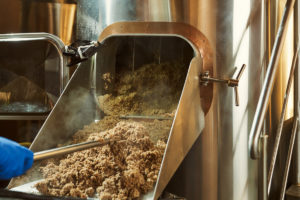Scotch Whisky – FMN February 2020
Now that the Super Bowl is over we can set our eyes on the impending spring. February does contain a holiday that beckons us to remember our ‘sweetheart’ or face the consequences. At this point most cliché beverage writers would swoop in with either pairing suggestions for the chocolatey wonders you bestow on your significant other or protestations about wine and chocolate making horrible bedfellows. This writer will do neither and avoid the subject by focusing on the most glorious beverage for Valentine’s Day, whisky. If you were vigilant with spelling you noticed that I stated whisky instead of whiskey, which would allude to the historical beverage, Scotch.
Whisky and whiskey differ in the types and amount of base grains used in their recipe, also known as a mash bill. For our purposes of discussing malted Scotch, the base grain is always barley. Historically, this decision came from availability, since this grain could tolerate some of the harsh Scottish growing environments and a serendipitous naturally-occurring conversion enzyme locked inside the barley itself. It’s almost as if barley was intended, by design, for fermentation.
Malted Scotch whisky gets its name from the malting process of steeping the barley in warm water and spreading the damp grain on malting floors. Traditionally turned with wooden shovels to prevent heat buildup, this laborious process unlocks the conversion enzyme that will be necessary to transform the starches to fermentable sugars that yeasts are able to consume. When the barley begins to germinate, now called ‘green malt’, the growth is arrested by the use of a kiln. The temperature, length of time and the presence or absence of peat will all impact the character of the final spirit.

The next step, referred to as mashing, begins with milling our grain into coarse flour (grist) that bathes in the mash tun with additions of progressively hotter water, releasing those magical conversion enzymes from the barley. The resulting sugary liquid, referred to as wort, readies for fermentation and the spent grains, draff, are used for animal feed. The wort is drained from the mash tun and placed in the washback for fermentation with a proprietary yeast strain (usually a safely guarded secret). The fermentation decisions (type of yeast, length and temperature of the fermentation) all help determine characteristics of the final spirit. The resulting liquid, called the wash or distillers beer, measures about seven to ten percent abv (alcohol by volume).
Scotch, as most brown spirits, sees at least two and sometimes three distillations as a batch process in a copper pot still. The wash undergoes the first distillation in an appropriately named wash still. This helps separate the liquid from some of the residual solids left after fermentation with the first distillate, called ‘low wines’ coming in around twenty-one to twenty-eight percent abv. The low wines are placed in a spirit still for the second fermentation, concentrating the alcohol and congeners (flavor compounds). The lighter alcohols are the first to come off (called the heads or foreshots). The next to evaporate are the hearts or ethyl alcohol, our desired spirit at seventy percent abv. The heavier compounds left behind are known as the tails or feints. The non-potable heads and tails are either discarded or mixed back into the low wines for the subsequent distillation.

The design and size of the still has a marked determination on the character of the spirit. Smaller pot stills, shorter necks and faster distillations all result in a heavier spirit. Also the ‘cut-point’ or where the heart ceases to be collected determines some of the final flavors. Some houses that produce peated Scotch allow the heart collection to dip into the feints to gain more of these peated phenolics.
Now we finally have our spirit we can move to the next step, maturation. The spirit is reduced to around sixty-three and a half percent abv then spends minimum of three years in oak barrels with a maximum capacity of seven hundred liters. The barrel size, age, amount of charring, and their original contents all impact the final spirit and the nature of the aging process. As Bourbon laws mandate use of new American oak, the Scotch industry remains the strongest secondary market for these barrels. They can promote flavors of vanilla, coconut, cherry and spice to the spirit. Sherry casks (butts) are also sometimes used to give nuances of dried fruit, clove, and orange peel. Finishing casks have become popular over the last few decades. This is where the spirit moves to a different style of cask for a short time before bottling. Some styles are port, sherry, madeira, wine and even some used beer barrels.
Before bottling the spirit undergoes cold filtration and second reduction with the addition of demineralized water. Most Scotch ranges from a compulsory bottling minimum of forty percent abv. to forty-three percent. There are some I’ve tasted in the mid fifty percent range but this goes outside the norm. As I, like the distillers themselves, reduce my Scotch for home consumption, the final abv has little consequence in my purchase decisions. I recommend a half ounce of distilled water to two or two and a half ounces of Scotch. The guilty feeling of needing to drink a Scotch ‘neat’ is misplaced and utterly incorrect.
While I’m on a rant about Scotch misinformation, I have been witness to the misuse and misunderstanding of the terminology associated with this historical hooch. Many proclaimed Scotch drinkers state they only drink ‘single malt’ and only over so many years old. The term ‘single malt’ means that the malted Scotch comes from one distillery, nothing more. Blended Scotch is a completely different category as pot-stilled malt is blended with a column stilled spirit. These are usually lighter, less complex and more approachable. Common labels such as Chivas Regal 12 year, Johnny Walker Black and Cutty Sark can readily be found on store shelves.
A ‘blended malt’ means that single malts from multiple distilleries are blended together to make a final product. Consumers often confuse these with the former ‘blended Scotch’ category, which they have little in common. This sharing of barrels takes place more than many think and can produce some amazing premium Scotch. One common example, Johnny Walker Green, gets credit to aiding in the revival of this category.
One final consideration when selecting a Scotch to bring home with you is region of production. The Lowlands tend to be lighter in style, no peat influence and no apparent salinity (Bladnoch, Glenkinchie). The Highlands and Islands have varying styles: from the peat influenced Highland Park, the rich and heavy Dalmore to the light and citric Glenmorangie. Campeltown Scotch tends to be rich and heavy with some brine elements (Sprinkbank, Glengyle). Speyside shows lighter styles (Glenfiddich, Glenlivit) and richer styles with dried fruit (Balvenie, The Macallan). Most Islay malts (Lagavulin, Laphroaig) tend to be moderate to heavily peated although some unpeated versions are available (Bruichladdich).
Although these whiskies are meant to sip and savor rather than pour and shoot, remember they do diminish in quality once opened. I recommend finishing a bottle within 6 months to a year once opened. Unopened bottles will not improve with bottle age but will keep for decades under cool, low light conditions. So whether you are binge watching Outlander and need some Scottish motivation, attempting to get in touch with your heritage or are celebrating Brexit, try this historical whisky.
Suggested Whisky Styles:
Speyside:
Glenfiddich India Pale Ale Cask (43% abv)
The spirit has a rich golden color with a nose of orchard fruit (apples and pears) in cooked cereal with a slight bit of cinnamon and walnuts. The palate mimics the nose with added vanilla, lemon / orange peel and a sweet hoppy finish. Pair with duck, grilled vegetables or a bad day at work.
Highland:
Glenmorangie Quinta Ruban (46% abv)
Aged 12 yrs with 10 yrs in American white oak and finished in ruby Port pipes from Portugal (about 130 gallons). The amber color is a testament to the Port cask finishing. The nose boasts dried and stewed fruits (orchard and berry) and spice (clove, cinnamon). The palate switches from fruit to salted caramel, caramelized sugar (marshmallow roasted over a fire), and a sweet / spicy bitter coco finish. Pair with lamb, beef spare ribs or dark chocolate.
Islay:
Laphroaig 15 year (43% abv)
The nose has sweet orchard fruit, vanilla, salted citrus peel and peat aromatics (pine tar, smoked fish). The palate has brined fruit, peppercorn and peat smoke with a lingering earthy, smoky finish. Pair with smoked pork ribs, hearty stews or pungent cheese.




